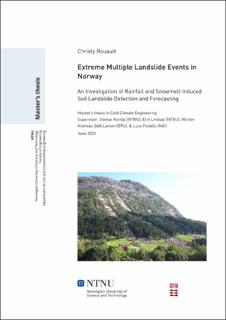| dc.description.abstract | Extreme events with multiple landslides can cause major economic costs, damage, and loss of life. While a single landslide can be destructive, multiple landslides are often the culprit of major losses. They can isolate communities and overwhelm emergency response by blocking transportation arteries and disrupting power and communication lines in several locations. In Norway, no red level warnings have been issued from 2015-2019, despite at least three events with severe damage and ≥20 landslides. Early warnings greatly benefit in mitigating the consequences of landslides. Due to the uncertainty in forecasting rare, high consequence events, improved understanding of past events is needed. This study aimed to (1) improve the landslide inventory and (2) analyse forecasting tools and warnings given for past events with multiple landslides, to assist in issuing more reliable warnings in the future.
21 Norwegian and four international multiple landslide case studies between 2015-2019 were investigated. Selected Norwegian case studies included days with ≥10 registered, geographically clustered, soil landslides. Two satellite landslide mapping techniques were tested using Sentinel-1 (SAR) and Sentinel-2 (δNDVI) images. Detection of registered landslides was attempted, and additional unreported landslides were mapped. Only 10% of landslides were detectable using SAR. Limiting factors of detection of selected landslides using SAR intensity, phase, and coherence, included snow, slope aspect, and spatial resolution. 45% of selected landslides were detectable using δNDVI. However, if only considering ideal conditions, the detection rate increased to 94%. In ⅓ of cases, δNDVI mapping nearly tripled the landslide inventory. δNDVI-mapping is hindered by snow and cloud cover, low sun angle, short daylight hours, and landslide size (>1000 m2). International test sites in arctic, urban, tropical, and monsoon conditions showed great potential for δNDVI-mapping, but limited success using SAR.
Forecasting tools, including the HYDMET threshold model, susceptibility maps, geology maps, rainfall and snowmelt, were analysed for the selected Norwegian case studies to identify correlations. Published warnings and warning evaluations of case studies were compared, in order to determine the main challenges in forecasting. Finally, the temporal and spatial trends of multiple landslide events were identified. Forecasting tools for the selected cases revealed varied usefulness. The HYDMET model underestimated hazard levels in 67% of cases. 84% of landslides occurred in high or very high susceptibility zones and have quaternary geology mapped as till, colluvium, or bare bedrock. Rainfall and snowmelt were the ultimate instigator of all selected cases, with normalized 24-hour water supply between 2.4% and 8.5% of mean annual precipitation. Return periods of 1, 3, and 24-hr water supply are ≤5 years in 11 cases and ≥100 years in six cases. Peak water-supply may not be captured by models or observed by rain gauges. The most challenging forecasting days are 1) uncertain high return period rainstorms and 2) spring melt with wet antecedent conditions. ⅓ of case studies were under-warned according to NVE evaluations. Days with ≥10 landslides are most common in Western Norway, due to a tempered climate and high precipitation, and rare north of Trondelag due to lower rainfall and cold, stable winters. These days occur nearly five times/year, with ¾ occurring in September to January.
Using δNDVI, landslide inventories in Norway could be drastically improved, albeit limited by cloud, snow, daylight, and landslide size. Improved inventories would help develop more reliable thresholds. However, this analysis indicates that despite a strong correlation in the majority of selected cases, rainfall and snowmelt alone cannot predict landslides. Better understanding of the role of the other influencing factors could reduce the number of under-warned multiple landslide events. | |
